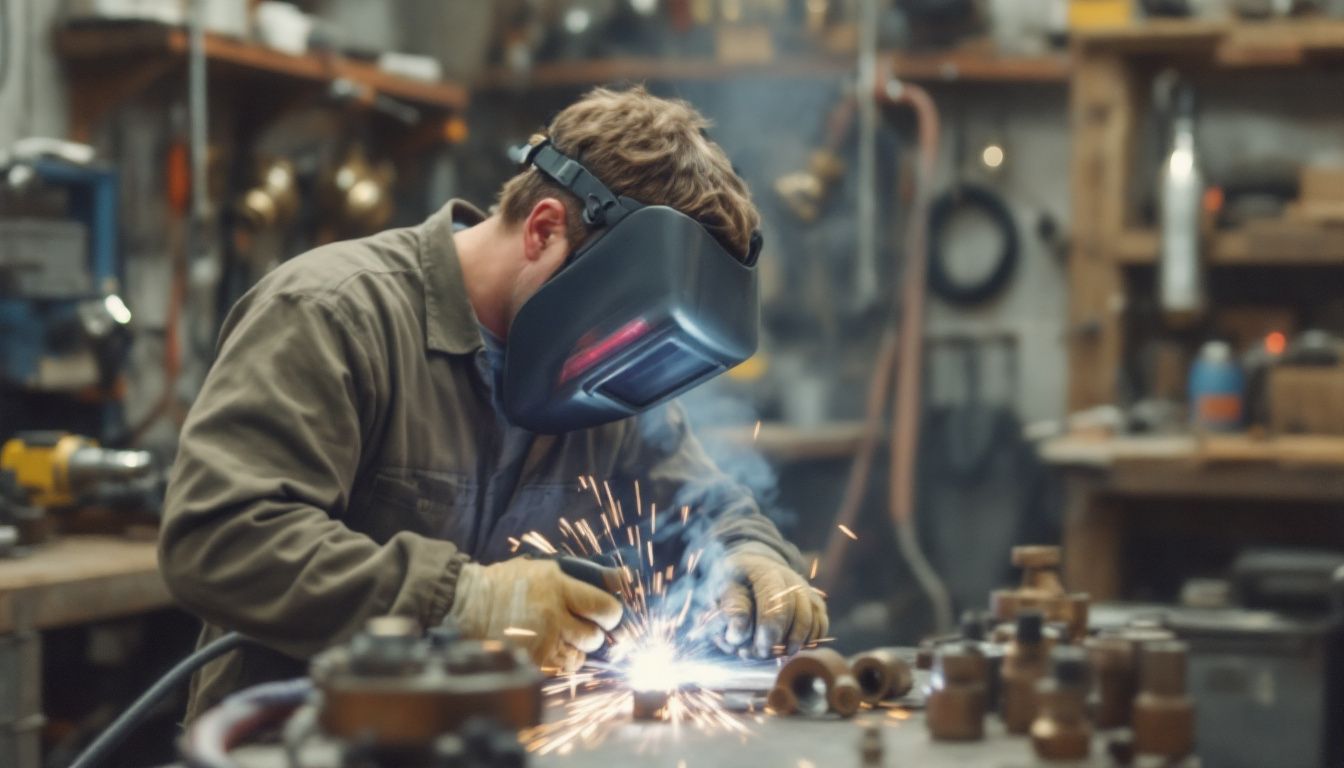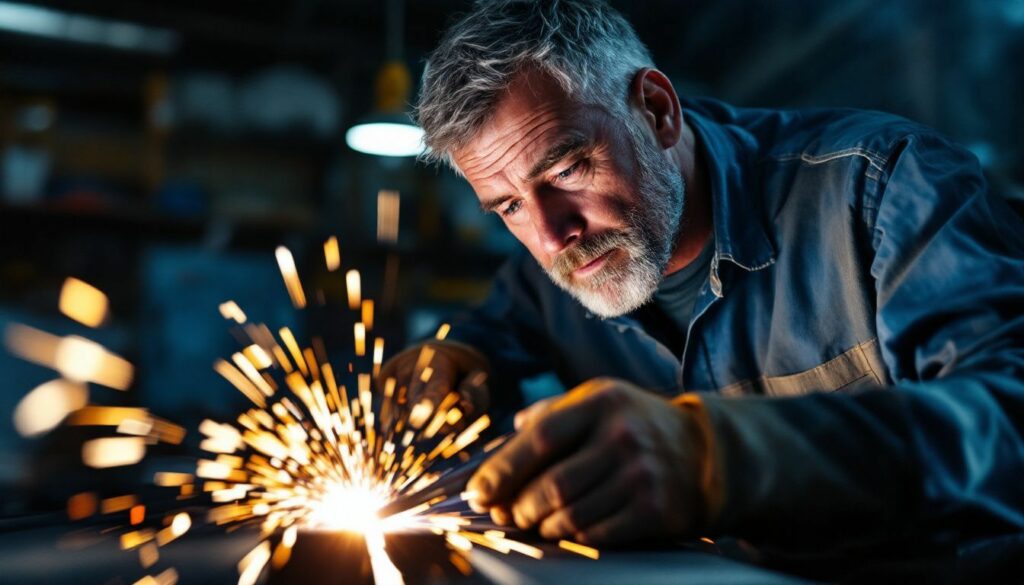Are you struggling to achieve strong and precise welds in your projects? Custom welding is essential for effective steel and aluminum fabrication. This article explores key techniques and the best tools to enhance your welding skills.
Get ready to master custom welding!
Key Takeaways
- Use MIG Welding for Steel and Aluminum: MIG welding is the main method for joining steel and aluminum. It uses a continuous wire feed for quick and clean welds, suitable for custom and heavy items.
- Advanced Aluminum Techniques: TIG welding and CNC machines provide high-quality seams and precise designs for aluminum. These methods ensure lightweight and durable fabrications.
- Wide Range of Fittings and Adapters: The shop offers Tri Clamp compatible fittings from 1/2″ to 12″, including NPT, hose barb, and cam & groove adapters. Reliable brands like Chugger and Blichmann are used for pumps and valves.
- Custom Welding Projects: Services include creating metal decor, railings, signs, and custom products like helmets and gloves. Popular products include Extension Tubes and Spray Ball Adapters, available through Mail-In Welding Service.
- Safety and Maintenance: Regularly inspect and clean welding tools. Use personal protective equipment and maintain a safe workspace. Proper equipment maintenance and ongoing training ensure high-quality and safe welding practices.
Key Techniques in Steel Fabrication

Steel fabrication relies on precise techniques to ensure durability and quality. MIG welding is a primary method used to join metal pieces efficiently. Our shop specializes in custom welding services, handling various steel types and sizes.
Cutting and shaping metal are done with advanced tools, ensuring each product meets exact specifications.
We offer a range of Tri Clamp compatible fittings, available from 1/2″ to 12″. Adapters like NPT, hose barb, and cam & groove are also provided. Our services include creating valves, elbows, and caps made to order.
By focusing on quality and customer service, we deliver customized welding solutions that meet diverse project needs.
Advanced Techniques in Aluminum Fabrication
Transitioning from steel, aluminum requires different approaches for optimal results. Precision is key when working with aluminum due to its lightweight and malleable nature. Advanced techniques like TIG welding offer high-quality seams, essential for custom metal projects.
CNC machines help fabricate intricate designs with accuracy, ensuring each piece meets specific requirements.
MIG welding is also popular for aluminum, providing strong and clean welds. Using the right filler material prevents corrosion and enhances durability. Tri Clamp compatible valves and pumps, such as those from Chugger and Blichmann, integrate seamlessly into custom aluminum structures.
Proper equipment and expertise ensure each fabrication project is unique and reliable.
Mastering aluminum fabrication opens doors to endless creative and commercial possibilities.
Custom Welding Projects and Applications
Building on advanced aluminum techniques, custom welding projects offer endless possibilities. Welders create unique metal decor, sturdy railings, and personalized signs. Outlaw Leather designs custom helmets, gloves, and caps available on Etsy.
Customers can request custom fittings through our contact form, ensuring each piece meets their needs. Featured products like the Mail-In Welding Service and BH Sparge Arm support specialized projects.
Bestsellers such as the Extension Tube and Spray Ball Adapter are popular for their reliability and quality. Whether for construction or artistic ventures, our custom welding services deliver professional results throughout the region.
Tools and Equipment for Precision Welding
Precision welding depends on tools like MIG welders and reliable safety equipment. Using these items ensures welds are strong and precise.
Focus on MIG Welding for Steel and Aluminum
MIG welding works great with both steel and aluminum. It uses a continuous wire feed, making the process quick and smooth. Welding companies use MIG to create strong ironwork or light aluminum parts.
Proper settings ensure each weld is strong and clean. Many fabricators trust MIG welding for custom made and heavy items alike.
MIG welding offers versatility and speed, essential for quality metal fabrication.
This technique is perfect for making custom hoods and helmets. Outlaw Leather uses MIG welding to build durable products. Aluminum parts, like temperature probes, need careful welding.
Professionals can repair and fabricate stainless or copper items easily. MIG welding supports a wide range of projects in the welding and fabrication industry.
Supplementary Insights on Custom Welding
Discover creative welding projects and learn how to use a stick welder while selecting the right materials—continue reading to find out more.
Artistic Welding Projects
Artistic welding projects transform welding metal into unique creations. On platforms like Etsy, custom welding products such as hoods, caps, helmets, and gloves are popular. Outlaw Leather sells custom welding hoods priced from $69.99 to $230.00.
These items blend functionality with style, appealing to welders who value both safety and appearance. Handmade signs also top the bestsellers list, showcasing craftsmanship and creativity.
Custom Welding Inc offers a wide stock of ornamental components, allowing artists to design gates and other decorative pieces. Precision in fabrication work ensures each piece stands out.
Keep in mind the importance of selecting quality materials to enhance the final product. Next, explore tips for choosing the right welding materials.
Tips for Selecting the Right Welding Materials
Choosing the right welding materials ensures strong and reliable projects. Follow these tips to select the best materials for your custom welding needs:
- Assess Material Requirements: Decide between steel and aluminum based on your project’s demands. Steel offers structural strength, while aluminum provides lightness and corrosion resistance.
- Check Tri Clamp Compatibility: Use Tri Clamp compatible fittings available in sizes from 1/2″ to 12″. This ensures your materials fit seamlessly with standard fittings like valves, gaskets, and pressure gauges.
- Select Quality Fittings and Components: Opt for specific Tri Clamp fittings such as 34mm clamps, ferrules, caps, elbows, tees, wyes, crosses, sight glasses, reducers, spools, check valves, PRV tank breathers, and pressure gauges to ensure reliability.
- Choose Reliable Pump Brands: Invest in pumps from reputable brands like Chugger and Blichmann. These brands offer Tri Clamp compatible pumps that enhance your welding system’s efficiency.
- Evaluate Thermowell Options: Pick thermowells that match your needs, whether straight-wall, MPT threaded, Tri Clamp compatible, or weldless. Proper selection aids in accurate temperature measurements and system protection.
- Purchase Stainless Tubing Wisely: Buy stainless tubing by the foot to have adequate material on hand. This approach saves time and ensures you have the right length for your projects.
- Verify Threaded Fittings: Use threaded fittings such as compression fittings, ball valves, and hex caps. These components provide secure and leak-free connections in your welding assemblies.
Following these guidelines will help your welding company maintain a commitment to quality and customer satisfaction. For more advice or a quote, please contact us.
Maintenance and Safety in Welding Practices
Proper maintenance and safety ensure high-quality welding and protect workers. Follow these guidelines to keep your welding practices safe and efficient.
- Inspect Equipment Regularly
- Check welding machines and tools for damage.
- Replace worn-out parts immediately.
- Ensure all connections are secure with a spanner.
- Clean Welding Tools
- Remove rust and debris from tools after each use.
- Use appropriate cleaners for steel and aluminum.
- Store tools in a dry, cool place to prevent fire hazards.
- Use Personal Protective Equipment (PPE)
- Wear helmets with proper shading to protect your eyes.
- Use gloves and protective clothing to prevent burns.
- Ensure PPE fits well and is in good condition.
- Maintain a Safe Workspace
- Keep the area free of flammable materials.
- Ensure good ventilation to avoid inhaling fumes.
- Use fire extinguishers nearby in case of emergencies.
- Follow Proper Welding Techniques
- Use MIG welding for precise steel and aluminum work.
- Adjust settings based on material thickness and type.
- Train workers to operate machinery safely and efficiently.
- Store Materials Correctly
- Keep steel and aluminum sheets off the ground.
- Use racks or ceilings to organize materials.
- Label all materials to prevent confusion during projects.
- Regularly Service Welding Equipment
- Schedule routine maintenance for all machines.
- Hire certified technicians for repairs.
- Keep a maintenance log to track service history.
- Provide Ongoing Training
- Teach workers about the latest safety practices.
- Update training materials as techniques evolve.
- Encourage staff to report any safety concerns immediately.
- Implement Fire Prevention Measures
- Install smoke detectors and fire alarms.
- Use fire-resistant curtains or barriers around welding areas.
- Conduct fire drills to prepare for potential incidents.
Following these steps will help maintain your equipment and create a safe welding environment.
Conclusion
Custom welding steel and aluminum opens many possibilities. Using MIG welding and the right tools ensures precise results. Always prioritize safety and keep your equipment in good shape.
Skilled welders create strong, lasting projects for any need. Apply these techniques to make your custom welding successful.
FAQs
1. What materials can I use for custom welding in fabrication?
You can use both steel and aluminum for custom welding. Each material has its own techniques. Aluminum requires more care, while steel is stronger for larger projects. Using the right material ensures a complete and sturdy fabrication.
2. How does numerical control improve welding operations?
Numerical control (NC) helps automate welding. It ensures precise measurements, like inch accuracy, and consistent quality. NC systems make the operation smoother, reduce errors, and speed up the completion of welding tasks.
3. Can I perform custom welding in-house for my business?
Yes, many businesses in the United States use in-house custom welding. This allows for greater control over the quality and timing of projects. Having in-house welding capabilities can also reduce costs and improve efficiency.
4. What experience is needed to certify custom welding techniques?
Certifying custom welding techniques requires hands-on experience and proper training. Welders must understand both steel and aluminum fabrication. Certification ensures that the welding meets industry standards and can accept complex projects.
5. How do custom welding and market research work together in fabrication?
Custom welding helps create unique parts, while market research identifies what customers need. By analyzing data, businesses can use custom welding to meet specific demands. This combination ensures the final product is both functional and aligned with market trends.

